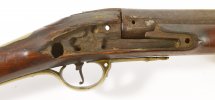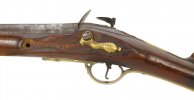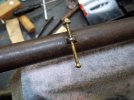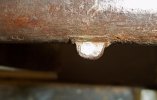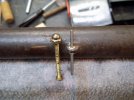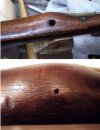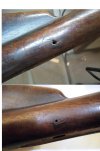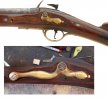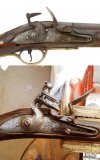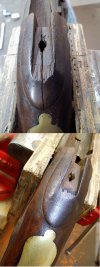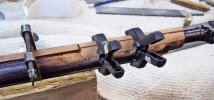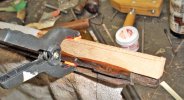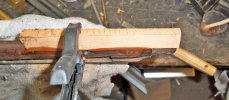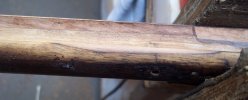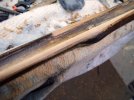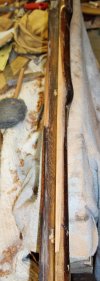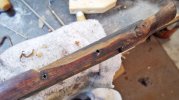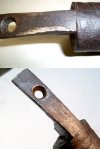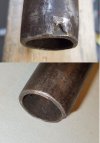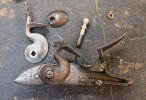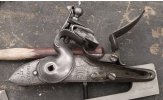Now to address the "Side plate". In my mind this is the most historical part of this firelock!
Those "Hash Marks"! Why are they there? Could it mean this Firelock was used for hunting after the War....and they designate the hunters skills over the years.....5 ( possibly 6 ) whitetails. Maybe bear or even wild hogs since this Scottish ancestor was from the Carolina's?
I would rather believe a more morbid providence, that these represent British Officers killed by the "Soldier Scotsman"fighting for Independence in America!
This one was a real mind-bender...Everyone knows the easiest way to match two pieces of something up is with a straight butt-joint! Silver solder 2 pieces of brass together and you have a repaired part!
Yes but it will look repaired. I had to come up with an Idea to solve that issue!
This repair once I finally came up with it, was not documented! It was my Idea and at the time it was my "trade secret" .....hey a guy has to have one!....But I'm sure I'm not going to be cornering the market in the Restoration / Conservation business at this stage in my life so here is my secret ...it is so simple the mind's thought process hides it!
I had no problem securing the proper brass replacement part ,
When Reeves Goehring was alive, GOD rest his soul; He produced brass castings with the Old English Brass formula, and his castings were all from original Firelocks! I'm sitting on probably 200 pounds of his castings in my shop! Heck he sold them for $10 a casting.... For Flintlock building his castings were the best soft brass ( not the hard wax cast bronze that is available today!) His castings, while coming from original parts could be bent, shaped, and altered easily!
Butt plates could be easily peened to fit an existing butt plate mortice, etc. Hands down the best!
He is gone now but his daughter has what is left of his inventory. She tried to have his moulds cast by the same foundry but because the original formula was causing the EPA to come down on them.....they had to stop casting his mix.
So let's continue:
Now I have an identical part ...of course without the 250 some year patina.....
I came up with a plan to disguise the butt-joint; I took the original rear part and cleaned up the break for it was a square sharp end ....I then matched up the new sideplate to the old and scored a cut mark on it. I cut the new piece with a jewelers saw to match the angle and position of the old cleaned up break! Putting the 2 pieces together the joint was pretty perfect but I know if I silver solder them I would have a shinny line!
I did not want that so what I did is turned the two parts over and cut a keyway with a diesinker chisel ( Don't us many power tools) perpendicular across the joint of both parts. I shaped a piece of scrap brass to fit this key way...I actually made it stand "proud" above the back surfaces of the plate to increase strength....I then silver soldered the piece in the keyway and was quite lucky that the solder did not flow to the front side of the butt-joint! I then re-inleatted the plate where the "proud key" was.
All I had to do now was to do some peening and distressing of the front side of the joint to disguise the splice.
Again Super Blue to the rescue! It puts a great patina on quality brass when applied with, not a cloth, but 0000 steel wool! When the blueing solution hits the steel wool there is an exothermic reaction so you have to work fast...just blend the patina to match the old!
Image below: You folks know where the repair is...However if you did not see the before's could you tell


